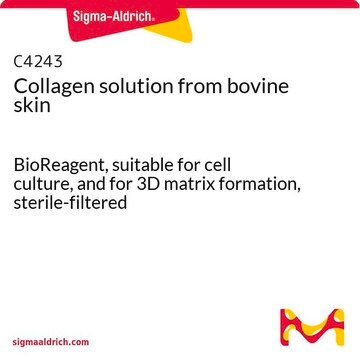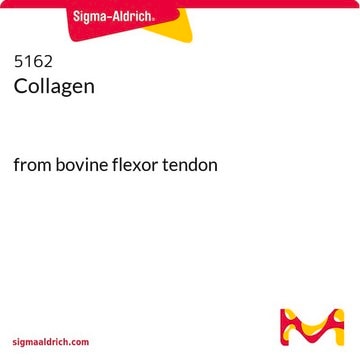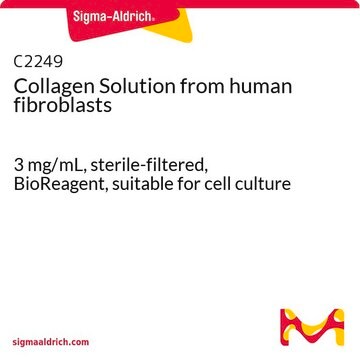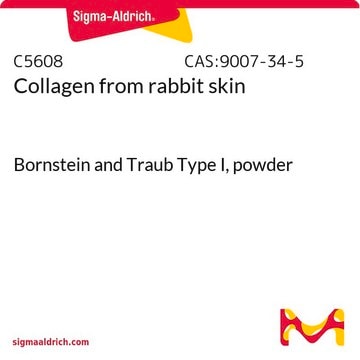C7661
Rat Collagen Type I
from rat tail, powder, suitable for cell culture
About This Item
Productos recomendados
product name
Colágeno from rat tail, Bornstein and Traub Type I, powder, BioReagent, suitable for cell culture
biological source
rat tail
product line
BioReagent
form
powder
mol wt
120—160 kDa
packaging
glass bottle of 5 mg
technique(s)
cell culture | mammalian: suitable
surface coverage
6‑10 μg/cm2
solubility
soluble
NCBI accession no.
UniProt accession no.
binding specificity
Peptide Source: Fibrinogen
Peptide Source: Laminin
storage temp.
2-8°C
Gene Information
rat ... Col1a1(29393)
¿Está buscando productos similares? Visita Guía de comparación de productos
Categorías relacionadas
General description
Application
- Immunohistochemistry
- Cellular activity assays
- Used in generation of dorsal root ganglion (DRG) explant cultures
- Used as one of the components during the preparation of the functionalized surface (in NMR setup)
- Used in cell culture (the glass coverslips were coated with nanowires at high concentrations mixed with collagen)
- Used for biofunctionalization of the microchannels
Biochem/physiol Actions
Preparation Note
Other Notes
Storage Class
11 - Combustible Solids
wgk_germany
WGK 1
flash_point_f
Not applicable
flash_point_c
Not applicable
ppe
Eyeshields, Gloves, type N95 (US)
Certificados de análisis (COA)
Busque Certificados de análisis (COA) introduciendo el número de lote del producto. Los números de lote se encuentran en la etiqueta del producto después de las palabras «Lot» o «Batch»
¿Ya tiene este producto?
Encuentre la documentación para los productos que ha comprado recientemente en la Biblioteca de documentos.
Los clientes también vieron
Artículos
The extracellular matrix (ECM) is secreted by cells and surrounds them in tissues.
Cancer stem cell media, spheroid plates and cancer stem cell markers to culture and characterize CSC populations.
Nuestro equipo de científicos tiene experiencia en todas las áreas de investigación: Ciencias de la vida, Ciencia de los materiales, Síntesis química, Cromatografía, Analítica y muchas otras.
Póngase en contacto con el Servicio técnico












